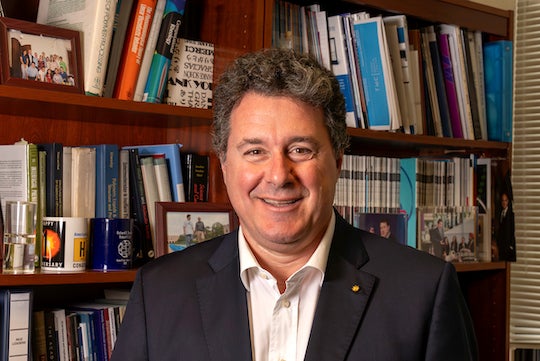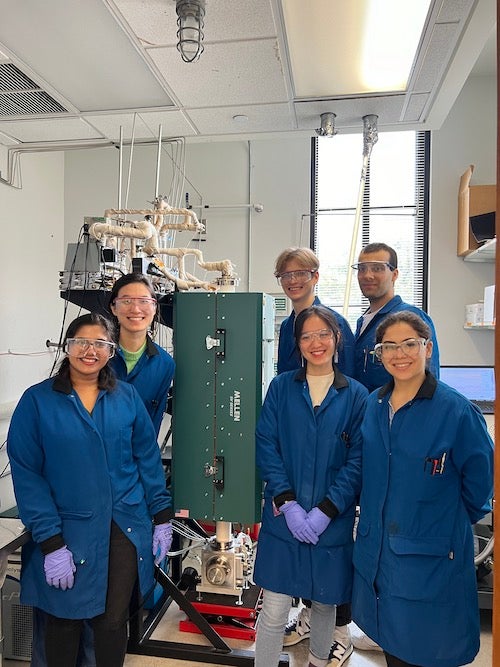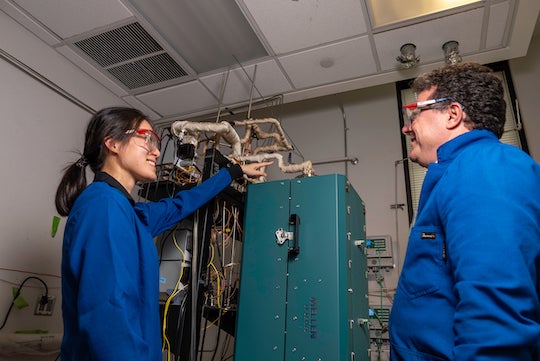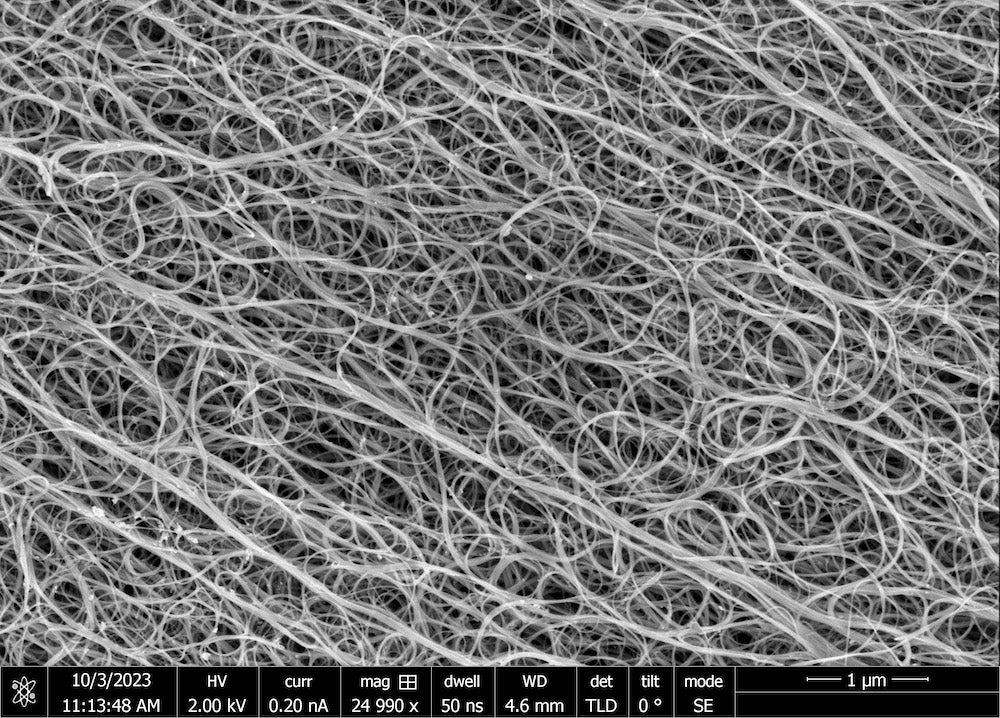An international team of scientists led by Rice University’s Matteo Pasquali has won a $4.1 million grant to optimize carbon nanotube synthesis, a process that could help drive the green energy transition by providing more sustainable alternatives to materials dependent on heavy industry. The award is a joint effort by The Kavli Foundation, with a $1.9 million Kavli Exploration Award in Nanoscience for Sustainability, and Rice’s Carbon Hub, which contributed an additional $2.2 million.
“The energy transition is primarily a material transition,” Pasquali said. “Renewable energy and electrification have a much larger material footprint than their counterpart fossil-based technologies. We need to break out of the current mindset that the energy systems of the future can be built with materials developed before chemistry became a mature science. We can now do this because we can control the structure and properties of solid carbon with an unprecedented degree of precision.”

Carbon nanotubes, or CNTs, are hollow cylindrical nanoscale structures made from carbon atoms. Their properties ⎯ excellent carriers of heat and electricity; very strong, though lightweight and with large surface area ⎯ make them useful in electronics, biosensors, batteries and more. In theory, they constitute an ideal net-zero end use for hydrocarbons such as natural gas, with the added benefit of hydrogen as a reaction byproduct. However, large-scale CNT synthesis still poses a challenge, one that Pasquali and his team hope their project will help address.
“We are at a critical juncture in carbon research, and it is really important that we shed light on the physical and chemical processes that drive CNT synthesis,” Pasquali said. “Currently, reactors are black boxes, which prevents us from ramping up synthesis efficiency. We need to better understand the forces at play in CNT formation by developing new tools to shed light on the reaction zone and find ways to leverage it to our advantage.”
Rice has a longstanding record of discovery and innovation in carbon research, spanning from Robert Curl and Richard Smalley’s 1996 Nobel Prize for their “discovery of carbon atoms bound in the form of a ball” to the present. Building on this history, Pasquali helped spearhead the establishment of the Carbon Hub, a coalition of corporations, academic and research institutions and nonprofit organizations aligned by the common goal of decarbonizing the economy.

“The research community has been making CNTs for years, but initially we’ve focused on getting properties on a small scale,” Pasquali said. “Once we attained properties, we also realized there is no intrinsic reason why we couldn’t be making these materials on a much larger scale. It became immediately obvious just how critical doing so could be for the green energy transition.”
According to Pasquali, in order to scale up CNT synthesis, a piecemeal, fragmented approach to the research is insufficient. Instead, the task calls for collaboration across disciplines, including ones that were not involved during the first wave of research and development. Because CNT synthesis evolved in multiple countries simultaneously, this called for the establishment of an international research collaboration.
“We have to apply a collaborative mindset to solve this problem,” Pasquali said. “We believe that by bringing together a dedicated interdisciplinary community, this project will lead to improvements in reactor efficiency and help identify further gaps in instrumentation and modeling.”
The Kavli Foundation, established in 2000 by Norwegian-American engineer and entrepreneur Fred Kavli, has emerged as a leading institution in promoting science advancements by supporting research in astrophysics, nanoscience, neuroscience and theoretical physics. Driven by a vision “to advance science for the benefit of humanity,” the foundation funds basic research in these four fields through partnerships, initiatives and portfolios designed to push the boundaries of science. This grant is part of its Nanoscience for Sustainability program, which seeks to unlock technologies of the future through innovation in materials research.

In addition to supporting basic research, The Kavli Foundation, in partnership with The Norwegian Academy of Science and Letters and The Norwegian Ministry of Education and Research, also established The Kavli Prize, honoring scientific breakthroughs “that transform our understanding of the natural world,” according to the foundation website. Many recipients of The Kavli Prize go on to win a Nobel Prize.
“We are proud to partner with Rice University to support this important high-risk, high-reward research,” said Amy Bernard, director of life sciences at The Kavli Foundation.
“The collaboration with The Kavli Foundation will allow individual teams working on the project to come together and work in a coordinated fashion,” said Pasquali, Rice’s A.J. Hartsook Professor of Chemical and Biomolecular engineering and professor of chemistry and materials science and nanoengineering and director of the Carbon Hub. “We are really excited about the breakthrough potential of this kind of exploratory approach that will allow us to include scientists working on complementary areas that are typically not involved in CNT research.”
Pasquali added that CNT synthesis is only part of a larger effort, facilitated by the Carbon Hub, to assemble a new material supply chain.
“When you want to replace a bridge made of stone with one made of steel, you don’t just replicate the same structure ⎯ you have to redesign the arch bridge and come up with the suspension bridge concept,” he said. “Synthesis is the cornerstone of this new supply chain, but other efforts need to be coordinated so that the material can be tried and deployed as pervasively as we do for metals and other industrial materials.”

In addition to Pasquali, Rice researchers involved in the project include Boris Yakobson, the Karl F. Hasselmann Professor of Engineering and professor of materials science and nanoengineering, and Thomas Senftle, assistant professor of chemical and biomolecular engineering.
The collaboration includes Adam Boies at University of Cambridge; Mauro Bracconi, Matteo Maestri and Matteo Pelucchi at Politecnico di Milano; Matteo Cargnello and Arun Majumdar at Stanford University; Phillip Christopher and Eric McFarland at UC Santa Barbara; Sili Deng at Massachusetts Institute of Technology; Chris Hogan and Marien Simeni at University of Minnesota; Christian Reece at Harvard University; Eric Stach at University of Pennsylvania; Mauricio Terrones at Pennsylvania State University; Jeff Blackburn of the National Renewable Energy Laboratory; Jeff Fagan of the National Institute of Standards and Technology; Seung Min Kin of the Korea Institute of Science & Technology; Benji Maruyama of the Air Force Research Laboratory; Raghu Sivaramakrishnan of Argonne National Laboratory; and Juan Jose Vilatela of the Madrid Institute for Advanced Studies, Materials.
- Video:
-
URL: https://youtu.be/qCLuNV03heI
(Video by Katie McKissick/The Kavli Foundation) - Image downloads:
-
https://news-network.rice.edu/news/files/2023/11/231114_Matteo-Pasquali_Gustavo-2.jpg
CAPTION: Matteo Pasquali is Rice’s A.J. Hartsook Professor of Chemical and Biomolecular Engineering, professor of chemistry and materials science and nanoengineering and director of the Carbon Hub (Photo by Gustavo Raskosky/Rice University)https://news-network.rice.edu/news/files/2023/11/Reactor-team-photo-2.jpg
CAPTION: Muxiao Li (top row, from left), Eldar Khabushev, Davide Cavuto, Jui Junnarkar (bottom row, from left), Mingrui (Lily) Gong and Ana Victoria Benavides-Figueroa (Photo courtesy of the Pasquali Research Group/Rice University)https://news-network.rice.edu/news/files/2023/11/231114_Matteo-Pasquali_Gustavo-13.jpg
CAPTION: Muxiao Li (left) and Matteo Pasquali (Photo by Gustavo Raskosky/Rice University)
https://news-network.rice.edu/news/files/2023/11/Rice-CNTs-SEM3-1.jpg
CAPTION: Scanning electron microscope image of carbon nanotubes. (Photo courtesy of the Pasquali Research Group/Rice University)
- Links:
-
Carbon Hub: https://carbonhub.rice.edu/
Pasquali Research Group: https://pasquali.rice.edu/Yakobson Research Group: https://biygroup.blogs.rice.edu/
Senftle Research Group: https://senftle.blogs.rice.edu/
Department of Chemical and Biomolecular Engineering: https://chbe.rice.edu/
Department of Materials Science and NanoEngineering: msne.rice.eduGeorge R. Brown School of Engineering: https://engineering.rice.edu
- About Rice:
-
Located on a 300-acre forested campus in Houston, Rice University is consistently ranked among the nation’s top 20 universities by U.S. News & World Report. Rice has highly respected schools of architecture, business, continuing studies, engineering, humanities, music, natural sciences and social sciences and is home to the Baker Institute for Public Policy. With 4,574 undergraduates and 3,982 graduate students, Rice’s undergraduate student-to-faculty ratio is just under 6-to-1. Its residential college system builds close-knit communities and lifelong friendships, just one reason why Rice is ranked No. 1 for lots of race/class interaction, No. 2 for best-run colleges and No. 12 for quality of life by the Princeton Review. Rice is also rated as a best value among private universities by Kiplinger’s Personal Finance.

